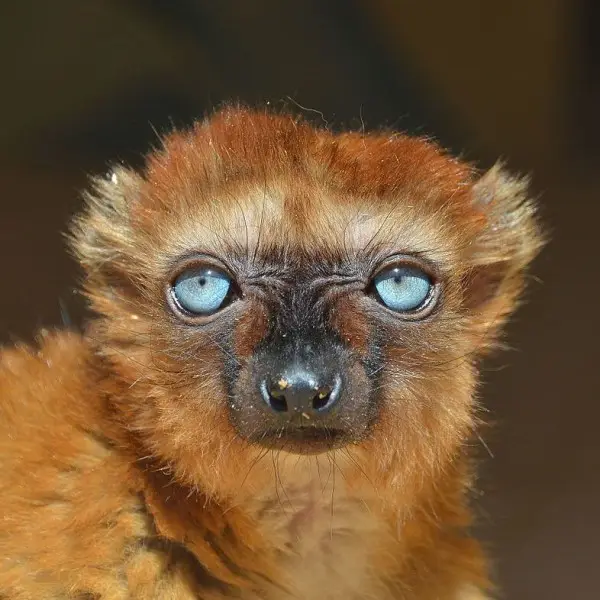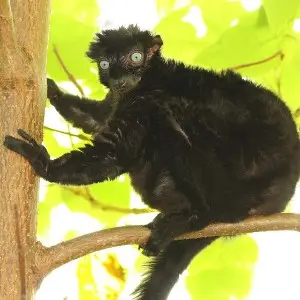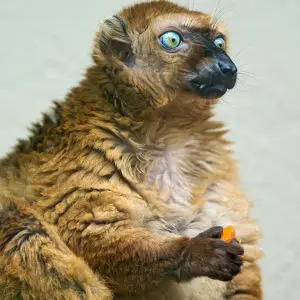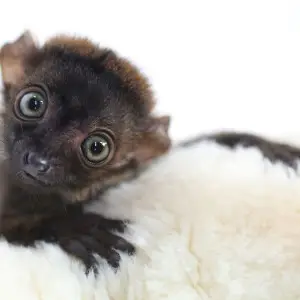Black Blue Eyed Lemur Baby Blue Eyed Black Lemur



Blue-Eyed Black Lemur
Sclater's lemur
One of the Madagascan lemur species most recently discovered could also be amongst the first to disappear. The Blue-eyed black lemur, identified as a species only in 2008, could be extinct within 11 years because of rapid deforestation of its only habitat. These striking animals already have a place on the list of the 25 most endangered primates in the world. Their population has declined more than 80 percent subsequent to their discovery in 1983. They were first considered a subspecies of the Black lemur but a few years ago they were finally reclassified as being a distinct species. The Blue-eyed black lemurs have striking sexual dimorphism in color. Males are black, and females have a coat that is reddish-tan in color over the entire body. They all have turquoise blue eyes.
Photos with Blue-Eyed Black Lemur





View 15 more photos of Blue-Eyed Black Lemur
Distribution
Geography
The Blue-eyed black lemur lives in Madagascar's northwestern tip. It occurs in primary and secondary sub-tropical dry and moist forests, from the north at the Andranomalaza River, to the south at the Maevarano River. It can readily be seen in forests south of Maromandia near Antananarivo and Antsiranana. It may also be found in the remaining patches of forest in the Sahamalaza Peninsula, e.g. the Ankarafa Forest.

Biome
Climate zones

Habits and Lifestyle
Little is known about the behavior of Blue-eyed black lemurs outside of captivity because there has not been extensive study of them in the wild. The following information was mostly recorded for black lemurs, and it is assumed to also be correct for this species. They live within social groups usually of 7 to 10 individuals, although there are groups from 2 to 15. As with most lemur species, females are dominant, and in each social group there are typically more males than females. The black lemur is active during both day and night, with most activity occurring early morning and late afternoon, an activity pattern called cathemeral, which means 'all hours'. Blue-eyed black lemurs use scent as their main method of communication, as do all lemurs, usually by rubbing their anogenital region on a suitable surface.
Diet and Nutrition
Blue-eyed black lemurs are herbivores, they mainly eat fruit, nectar, and pollen. In the dry season they may eat leaves, berries, and seeds, with insects being a rare addition.
Mating Habits
April-June in Madagascar, November-December in northern hemisphere
The Blue-eyed black lemur is thought to be polygynous, which means that one male mates with multiple females. In Madagascar, mating is from April to June. In the northern hemisphere most breeding takes place in November and December, and births occur in March and April. The gestation period lasts for about 120-129 days. Usually a single offspring is born, but sometimes there are twins do occur. A baby clings to its mother's belly for its first 3 weeks, changing its position only to nurse. From three to four weeks old, a young lemur begins to make short forays of about a foot away from its mother, scurrying back to her belly when startled. It will begin to try solid food at the age of 4-6 weeks, any of the food that its mother or other group members in a nearby group are eating. Nursing continues, but becomes steadily less important in the infant's diet, and weaning occurs at 5 – 6 months old. Young lemurs are sexually maturity at around 2-3 years old.

Population
Population threats
The main threat to the Blue-eyed black lemur comes from deforestation, especially slash and burn agriculture throughout its entire range. It is also hunted as a food source, for the pet trade and because it raids crops.
Population number
According to the Wikipedia resource, the total Blue-eyed black lemur population size is around 1,000 individuals. Today this species' numbers are decreasing and it is classified as Critically Endangered (CR) on the IUCN Red List.
Ecological niche
The Blue-eyed black lemur helps with the propagation of many rainforest plants by spreading the seeds of over 50 different species through depositing their waste. It is possible that some plants have evolved specifically for dispersal by this species. They also pollinate many plants during the process of eating nectar and pollen from these plants.
Fun Facts for Kids
- Males and females of this species look very different. The males are totally black, while females are brownish gray and have a gray face framed with white tuffs of spiky hair.
- Males have two techniques of scent marking which the females do not have. One is marking by rubbing the palm and wrist energetically backwards and forwards for a few seconds or minutes on a branch or some other surface. The other technique is head rubbing, done by lowering the head and rubbing the surface once or twice with it.
- Blue-eyed black lemurs greet each other by means of reciprocal fur grooming.
- Often Blue-eyed black lemurs will feed by hanging upside down by their feet.
- Blue-eyed lemurs are one of just two non-human primates with truly blue eyes.
References
More Fascinating Animals to Learn About
Source: https://animalia.bio/blue-eyed-black-lemur
0 Response to "Black Blue Eyed Lemur Baby Blue Eyed Black Lemur"
Post a Comment